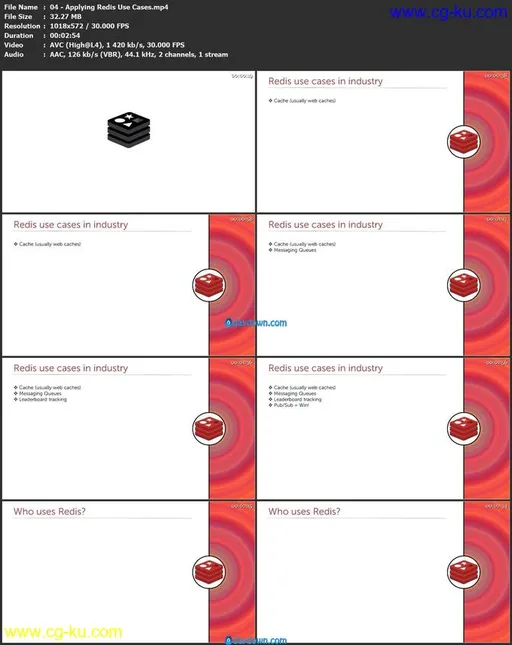MP4 | Video: AVC 1018x572 30 fps | Audio: AAC 44.1 KHz 2ch | Duration: 2h 7m
Genre: eLearning | Language: English | Size: 603 MB
The following 12 topics will be covered in this Redis course:
Introducing this Redis Course. Know what is required to get the most out of this course, including knowledge of general programming concepts, relational databases, web architecture, and Bash / Linux. Learn that Redis is a powerful open source in-memory data structure store.
Introducing Redis. Be able to explain what Redis is in this second topic of the Redis course. Learn what resources are available at Redis.io. From the Redis.io website: “Redis is an open source (BSD licensed), in-memory data structure store, used as a database, cache and message broker. It supports data structures such as strings, hashes, lists, sets, sorted sets with range queries, bitmaps, hyperloglogs, geospatial indexes with radius queries and streams. Redis has built-in replication, Lua scripting, LRU eviction, transactions and different levels of on-disk persistence, and provides high availability via Redis Sentinel and automatic partitioning with Redis Cluster.”
Comparing Redis to Relational Databases. Know the differences between Redis and traditional relational databases in this third topic in the Redis course. Become comfortable with the role of primary keys and foreign keys. Witness the power of key-value databases.
Applying Redis Use Cases. Be able to appreciate how Redis can be leveraged in various industries in this fourth topic in the Redis course. Redis is used in areas such as for cache, messaging queues, leaderboard tracking. Many organizations use Redis including craigslist, stackoverflow, Twitter, and Flickr.
Setting up the Redis Development Environment. Set up the Redis development environment in this fifth topic in the Redis course. Complete the Redis installation including setting up your virtual machine.
Using Redis Keys. Use Redis keys in this sixth topic in the Redis course. Run both the Redis Server and Command Line Interface to see the powerful feature of Redis keys. Follow along with Luca and use the PING, SET, GET, and DEL commands.
Using Redis Lists. Become proficient with Redis lists in this seventh topic in the Redis course. Practice adding and removing elements to the list (array). Use a number of Redis commands including LPOP, LPUSH, LPUSHX, LRANGE, LREM, LSET, and LTRIM.
Using Hashes in Redis. Practice using hashes in this eighth topic in the Redis course. Hashes are similar to dictionaries in Python or hash maps in Java. Practice storing multiple field values under one key (hash).
Using the Publish Subscribe (Pub/Sub) Pattern in Redis. Practice working with the Publish Subscribe (Pub/Sub) Pattern in this ninth topic in the Redis course. From redis.io: “…senders (publishers) are not programmed to send their messages to specific receivers (subscribers). Rather, published messages are characterized into channels, without knowledge of what (if any) subscribers there may be. Subscribers express interest in one or more channels, and only receive messages that are of interest, without knowledge of what (if any) publishers there are. This decoupling of publishers and subscribers can allow for greater scalability and a more dynamic network topology.” Follow along with Luca and become proficient with the Pub/Sub pattern in Redis.
Leveraging Python with Redis. Leverage Python with Redis using the redis-py library in this tenth topic in the Redis course.
Creating a Redis Application. Apply all of the techniques learned in the prior sessions to create tasks for a Redis application in this 11th topic in the Redis course.
Summarizing this Redis Course. Reinforce the key messages from this class and see how to further improve your Redis skills, in this 12th topic in the Redis course.


发布日期: 2019-11-08